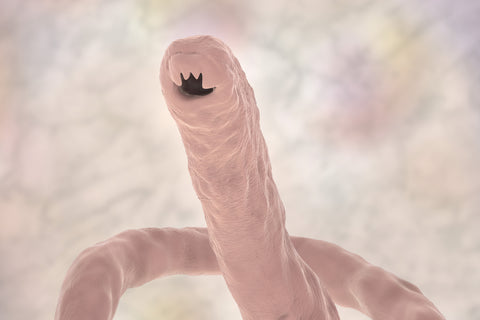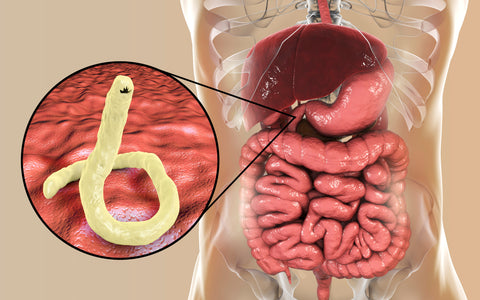Ancylostoma Duodenale: A Parasitic Hookworm
March 29, 2024
Ancylostoma duodenale, a parasitic hookworm, is a leading cause of anemia and malnutrition in many developing regions. While this parasite is often overlooked, it is responsible for a considerable burden of disease globally. Characterized by its unique life cycle and distinct physical features, Ancylostoma duodenale can pose significant health risks. In this article, we will discuss this parasite in detail, including its transmission, symptoms, and treatment.
What is Ancylostoma duodenale?

Ancylostoma duodenale is a species of hookworm commonly found in the duodenum of humans. It's a tiny, blood-sucking nematode that clamps onto the intestinal wall with its sharp teeth, feeding on the host's blood, which can lead to anemia and protein malnutrition. (1)
The Starting Point: Ancylostoma duodenale Egg
The life of Ancylostoma duodenale begins in the form of a microscopic egg laid within the small intestine of an infected person. These eggs are passed out of the body through feces into the soil. Warmth and moisture in the soil are perfect for these eggs to hatch into larvae, the next stage in their life cycle.
A Detailed Cycle: Ancylostoma duodenale Life Cycle
The life cycle of Ancylostoma duodenale involves:
- Larval Hatching: In warm, moist soil, the eggs hatch into larvae, which are free-living and can survive in the environment for weeks.
- Skin Penetration: These larvae are infectious and can penetrate human skin when people come into contact with infested soil, often through bare feet.
- Bloodstream Travel: Once inside the body, the larvae travel through the bloodstream to the lungs.
- Lung to Throat Migration: They then move up the respiratory tract to the throat, where they are swallowed down into the gut.
- Maturation: Back in the intestines, they mature into adult worms and attach to the intestinal walls, completing the cycle. (1)
Comparing Ancylostoma duodenale and Necator americanus
Ancylostoma duodenale has a close relative, Necator americanus, another hookworm species. They share a similar life cycle but differ in where they're typically found geographically and how they latch onto the intestinal wall. Necator americanus uses cutting plates instead of teeth. (2)
Under the Microscope: Ancylostoma duodenale Morphology

The morphology, or structure, of Ancylostoma duodenale is unique and includes:
- Mouthparts: It possesses a distinct buccal capsule with two pairs of ventral teeth used for anchoring to the host's intestinal wall. (3)
- Size: Adult worms measure around 10 mm in length, with females being slightly larger than males.
- Body Shape: The worm has a cylindrical body with a slightly curved tail, giving it the 'hook' shape that's behind the name 'hookworm.'
Hookworm Disease
Ancylostoma duodenale's presence in humans can lead to a condition known as ancylostomiasis, or hookworm disease, which is a major cause of iron-deficiency anemia in endemic regions. The consequences of infection can be particularly severe for pregnant women and children, leading to developmental issues and cognitive impairment. (4)
Symptoms of Hookworm Infection

An infection with Ancylostoma duodenale can lead to a variety of symptoms. These symptoms often start with the initial entry of the larvae into the skin and can become more severe as the worms mature and begin to feed on the host's blood.
Initially, the entry point of the larvae can cause a localized skin reaction known as 'ground itch,' which is usually the first sign of infection. As the larvae migrate to the lungs and are coughed up and swallowed back into the digestive system, respiratory and gastrointestinal symptoms can develop.
Once the worms have established themselves in the intestines, their feeding can cause internal blood loss, leading to anemia and protein malnutrition. This loss of nutrients can result in a range of symptoms related to these deficiencies. The severity of symptoms generally correlates with the number of worms present in the intestines; heavier infestations tend to result in more pronounced symptoms.
Here's a list of common symptoms associated with hookworm disease:
- Itchy rash
- Cough
- Fever
- Wheezing
- Abdominal pain
- Diarrhea
- Loss of appetite
- Weight loss
- Fatigue
- Anemia
- Protein malnutrition
Children with heavy infections can experience developmental issues and cognitive challenges. It's also worth noting that some individuals may not show symptoms but can still spread the disease through the environment if proper sanitation isn't practiced. (5)
Getting Rid of a Hookworm Infection
Getting rid of a hookworm infection typically involves following a course of anti-parasitic medications. The goal of treatment is to eliminate the worms from the body to alleviate symptoms and prevent the long-term health consequences of infection.
The primary medications used to treat hookworm disease are:
- Albendazole
- Mebendazole
- Ivermectin
- Pyrantel Pamoate
Some people prefer to use natural antiparasitic remedies to support the elimination of hookworm infections. Our Parasite Detox tonic helps to eliminate a variety of different parasites at various stages of growth. It is recommended to consult with your doctor before use to make sure this formula is right for you. Additionally, if you suspect you have a hookworm infection it is important to consult a medical professional for proper diagnosis and treatment.
In addition to using an anti-parasitic remedy, managing hookworm disease also involves addressing the complications that arise from the infection, such as:
- Iron Supplements: To combat iron-deficiency anemia, iron supplements are often prescribed.
- Nutritional Support: A diet rich in protein and other nutrients can help patients recover from the malnutrition that often accompanies heavy hookworm infestation.
- Hygiene Education: To prevent reinfection, patients are educated on the importance of personal hygiene, proper sanitation, and wearing shoes in endemic areas.
- Monitoring and Follow-Up: It's important to check for the presence of eggs in the stool after treatment to ensure that the worms have been completely eradicated.
Treatment efficacy is generally high, and most individuals recover fully with appropriate intervention. However, in areas where hookworm is endemic, reinfection can occur, necessitating ongoing public health measures to control the spread of this parasite.
Prevention of Hookworm Infection

Preventing Ancylostoma duodenale infections requires proper sanitation and being mindful of where we choose to be barefoot. Public areas, areas where pets or animals commonly roam, and areas with poor sanitation are more likely to contain hookworm larvae in the soil. It is recommended to avoid walking barefoot in these places to prevent skin contact with contaminated soil.
Summary
Ancylostoma duodenale, a species of hookworm, is extremely common in tropical and subtropical areas, affecting millions of people worldwide. It is primarily contracted through walking barefoot on contaminated soil. For this reason, it is recommended to avoid walking barefoot in endemic areas and to practice proper sanitation and hygiene. While hookworm infections can cause numerous symptoms, treatment efficacy is generally high. Ancylostoma duodenale is an important species to be aware of, and understanding its life cycle and the risks of contamination can help you prevent getting a hookworm infection, so you can stay healthy and well.
References
1 https://www.ncbi.nlm.nih.gov/books/NBK507898/
2 https://www.ncbi.nlm.nih.gov/books/NBK546648/
3 https://www.ncbi.nlm.nih.gov/pmc/articles/PMC7806429/
True Health Starts with Feeding the Body


